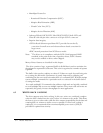
6-8 Maxtor Atlas 10K V
allocated at the end of each band, and are reserved for grown, revectored blocks. All
grown defects are reallocated to one of the spare blocks, using a “nearest neighbor”
algorithm.
If bad block replacement is enabled (via the AWRE and ARRE bits in the Read-
Write Error Recovery Page), blocks that are difficult to read or write may be replaced
after multiple retries.
If the bad block data is recoverable, the drive first verifies that the original block
location is bad with multiple write tests. If the write tests fail, the original data is
reassigned to a new location.
6.14 THE ULTRA160 and ULTRA320 LOW VOLTAGE DIFFERENTIAL
(LVD) SCSI INTERFACE
SCSI-3 provides increased performance and versatility to SCSI disks. LVD uses lower
level voltage swings, differential signaling, and double transition (DT) clocking to
allow a maximum bus speed of 160 or 320 MB/second in wide SCSI configurations.
The Maxtor Atlas 10K V disk drive supports the LVD/MSE (Multi-Mode LVD and
Single-Ended) interface standard. When installed on a bus with only LVD devices the
Maxtor Atlas 10K V disk drive operates in LVD mode at transfer rates up to 160 or
320 MB/second. It is fully compatible with Ultra2 LVD devices operating at slower
transfer rates. If an Maxtor Atlas 10K V disk drive is installed on a bus with one or
more single-ended (SE) devices, it automatically switches modes to operate in SE
mode at the slower, legacy data rates.
Differential SCSI operation has the advantage of higher reliability of data transfer
through increased immunity to electrical noise. Differential signaling uses a two-wire
active system in which current from each wire flows in opposite directions and
reverses direction for a signal transition. The direction of current flow determines
whether the voltage levels on the two wires have a high/low or low/high relationship
to each other. The common mode, or reference, level for the two LVD signals is
+1.25 volts. High and low is defined relative to this level. LVD permits a wide range
of signal amplitudes. The Maxtor Atlas 10K V interface drivers are designed to provide
a high to low range on each signal of approximately 400 millivolts in a nominal
configuration, resulting in a differential signal of approximately 800 millivolts.
Single-ended SCSI, in contrast, uses one-wire active signaling with the signal return
wire connected to ground. The active signal range is switched between a high in the
range of +2.4 - 3.0 volts and a low in the range of 0 - +.5 volts. LVD/MSE SCSI
devices in single-ended mode do not have the signal return wires connected directly
to ground, as these same pins must be driven to LVD levels when the device is
operating in LVD mode. Instead, when in single-ended mode, the device turns on a
driver transistor for each return line that acts as a switch to connect the signal return
to ground.


















